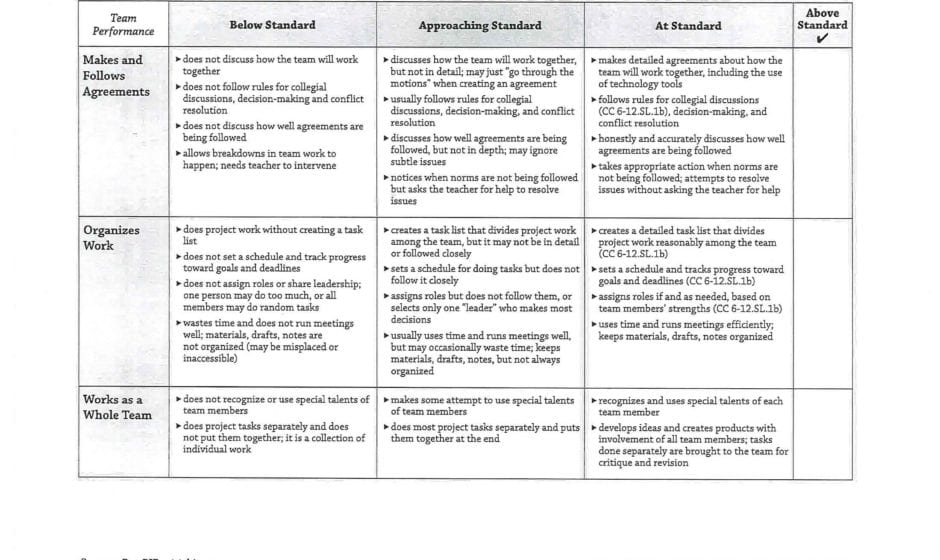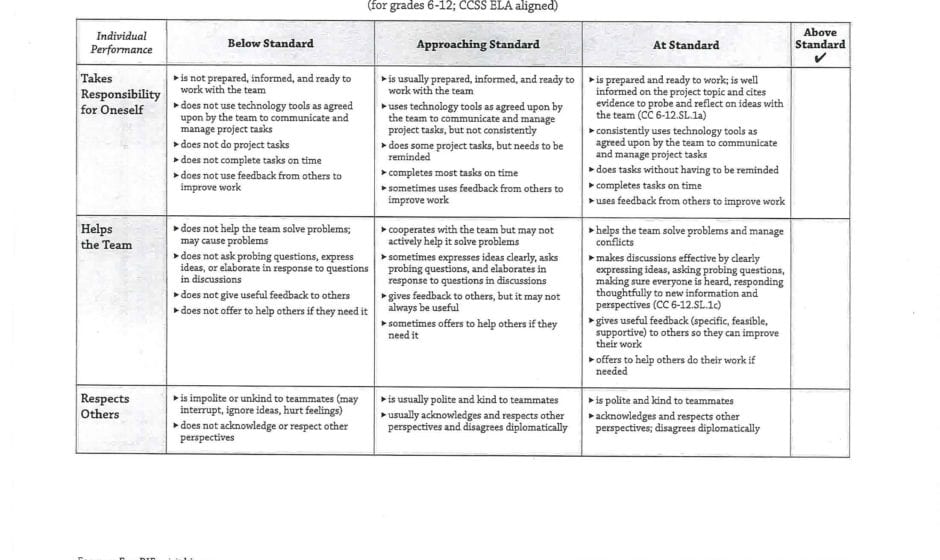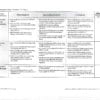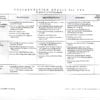The Search for Identity Through Literature & Song
Developed by Hilda Shirley
Coy Middle School, Beavercreek, OH
Honors English/Language Arts
Grade Level: 6
Introduction
Taking a risk can be scary for students. This is especially true of middle school-aged learners. Sometimes they balk when a teacher tries something new during the instructional process. Teacher Hilda Shirley from Coy Middle School took that chance with her 6th grade students when she incorporated songwriting into her language arts lesson about self-discovery and identity in the novel A Long Walk to Water by Linda Sue Park. Many young people are particularly reluctant to present in front of each other in any kind of performance. However, because Hilda had attended the Muse Machine’s Advanced Teacher Training Seminar and their Summer Institute, she felt at ease bringing music-making and performance into her classroom. The theme of Identity was woven throughout many of the plays chosen for the ATTS experience. Hilda carefully chose learning scaffolds to integrate into her instructional process that allowed students to feel comfortable and safe as they wrote songs about the themes of the novel. They could choose a buddy to write with and could play an instrument if they felt uncomfortable singing their song. Muse Machine challenges teachers to step outside their comfort zones as they learn to challenge their students to do the same. Kudos to Hilda and her students as they struck a new chord for learning!



Strand / Process
Ohio’s Learning Standards for English/Language Arts (adopted 2017)
NOTE: This lesson will occur over three to four days. Prior to starting this lesson, students in my honors ELA class read the nonfiction book Lost Boy, Lost Girl: Escaping the Civil War in Sudan (by John Bui Dau and Martha Arual Akech). Students also read the fiction novel A Long Walk to Water (by Linda Sue Park). Students will use these resources as inspiration in the writing on a twelve-bar blues song.
RL.6.1 Cite textual evidence to support analysis of what the text says explicitly as well as inferences drawn from the text.
RL.6.2 Analyze literary text development.
a.Determine a theme of a text and how it is conveyed through particular details.
b.Incorporate a theme and story details into an objective summary of the text.
RL.6.3 Describe how a particular story’s or drama’s plot unfolds in a series of episodes as well as how the characters respond or change as the plot moves toward a resolution.
W.6.3 Write narratives to develop real or imagined experiences or events using effective technique, relevant descriptive details, and well-structured event sequences.
a. Engage and orient the reader by establishing a context and introducing a narrator and/or characters; organize an event sequence that unfolds naturally and logically.
b. Use narrative techniques, such as dialogue, pacing, and description, to develop experiences, events, and/or characters.
c. Use a variety of transition words, phrases, and clauses to convey sequence and signal shifts from one time frame or setting to another.
d. Use precise words and phrases, relevant descriptive details, and sensory language to convey experiences and events. e. Provide a conclusion that follows from the narrated experiences or events.
W.6.4 Produce clear and coherent writing in which the development, organization, and style are appropriate to task, purpose, and audience.
Content Statement
Enduring Understandings
After reading the novel A Long Walk to Water, written by Linda Sue Park, students will work in groups to create (and ultimately perform for their classmates) a twelve-bar blues song. Students will be encouraged to approach the creation of their group’s blues song much like writing a poem with use of figurative language (alliteration, rhyme, etc.). Students will be allowed to focus on a single character or major event from the novel to inspire their lyrics. The goal of the song is to show how an individual’s IDENTITY is influenced/shaped by his/her environment, the people in his/her life, and/or the challenges that he/she faces.
Level of Inquiry
(confirmation/structured/guided/open)
Students, working in groups, will have structured prewriting/brainstorming sessions/activities to guide them in writing/creating a 12-bar blues song.
Progress Points
- Daily in-class observations
- Final performance observations
- Student survey
Discipline
Strand/Process
Working in groups to create an original twelve-bar blues song that will reflect how a person’s IDENTITY is shaped by environment, people around him/her, and challenges that he/she faces. The song will be based on a character or real life person that students read about in A Long Walk to Water or Lost Boy, Lost Girl: Escaping the Civil War in Sudan.
Essential Question(s) and Big Ideas
NOTE: The class would have already discussed the literary elements – character, theme, plot development – of the novel A Long Walk to Water prior to beginning this lesson.)
Students will be asked to consider the following questions throughout the lesson:
- How does a person’s IDENTITY develop over time?
- What or who influences the development of one’s IDENTITY?
- Are our IDENTITIES predetermined? Or do individuals have the power to change who he/she will become as an individual? If so, HOW?
Content Elaborations
Students will …
- examine various influences of IDENTITY.
- learn to write a blues song from a perspective/ point-of-view different from their own.
- show their understanding of the elements/aspects of the theme, character(s), and plot development for A Long Walk to Water via the lyrics of their twelve-bar blues song.
- develop oral communication skills.
- be able to take ownership of the subject matter.
- *develop teamwork skills.
Expectations for Learning
Students will demonstrate this learning by …
- participating daily in class.
- creating a 12 line blues song
- brainstorming/prewriting piece that reflects an understanding of the theme, character(s), and plot development of the whole class novel A Long Walk to Water.
- participate in group and wholeclass discussions regarding the development of IDENTITY.
Instructional Strategies
Students will be engaged and supported in learning by …
- direct instruction to introduce a brief history of the blues genre.
- viewing a series of short videos about the blues genre (via Youtube.com – example: Jazz Fundamentals: What are the Blues?).
- listening to a variety of blues music (twelve-bar) to use as examples and models.
- teacher-led and student-led discussion on how IDENTITY is shaped and influenced by one’s environment, people, and challenges faced.
Assessment (Pre and/or Post)
Students will know how well they are learning by …
POST-ASSESSMENT
- performing final song for whole class
Materials & Resources
Materials list for teachers
- computer
- projector
- access to Jazz Fundamentals (via YouTube)
Materials list for Students
- iPad
- iMovie App
- access to twelve-bar blues back tracks
- student owned or school issued musical instruments
- copy of A Long Walk to Water and/or Lost Boy, Lost Girl
Key Vocabulary
Key terms that need to be defined prior to or as part of instruction (arts, non-arts, and common)
BLUES VOCABULARY
- blues
- call and response
- back track
- improvisation
ELA VOCABULARY
- theme
- figurative language
NON-CONTENT VOCABULARY
- environment
- development
Student Performance Tasks
Describe in detail the activity of the lesson …
After reading A Long Walk to Water (or Lost Boy, Lost Girl) and viewing a series of videos and discussing how to write a twelvebar blues song, students will work in small groups to create an original blues song that will showcase/illustrate the development of the IDENTITY of one of the characters. In writing their song, the groups must be sure to incorporate how the character’s IDENTITY is influenced by the environment, people around him/her, and/or the challenges faced. Students will be permitted to select a twelve-bar blues backing track from on line sources. In addition, students will also be able to use their own musical instruments if desired. Upon completion of writing their song, students will perform for the class.
Application/Career Connections
Arts, non-arts, and common:
- songwriting
- group work/collaboration
- technology
Diverse Learners
How will instruction be differentiated according to learner needs?
Students will collaborate in small groups. Because this assignment is out of their comfort zone, students will be allowed to select one classmate that he/she wants to work with. Pairs will then be combined to form the small group. This will ensure that every student has a “buddy” that he/she is comfortable working with.
In addition, students will have access to teacher support/guidance throughout the assignment and will be allowed to move at a variety of paces.
Students who are not comfortable with singing will be allowed to play a musical instrument of their choice.
Interdisciplinary Connections
ATTS Connection
In June 2017, I had the opportunity to attend the Muse Machine ATTS. The primary theme discussed at many of the workshops that week was IDENTITY. In addition, I attended the Muse Summer Institute for Educators in July 2017 which focused on the musical genres of blues and jazz.
Reflecting on the activities, workshops, and shows that teachers participated in and attended during the 2017 ATTS, I looked for ways to connect the theme of IDENTITY to my ATTS lesson plan. I began to think about how every individual’s IDENTITY has been influenced or shaped by the environment he/she lives in, the people in his/her life, and the challenges he/she faced over a period of time. I thought about the different characters portrayed in both the plays and musicals we attended including: Sweat, Oslo, Six Degrees of Separation, and Dear Evan Hansen. All four pieces have very different storylines and very different characters; however, one element remains constant throughout: Human IDENTITY is shaped by the environment we live in, the people in our lives, and the challenges we face.
It will be this element that my students will focus on as they create a final product. They will use this theme to reflect on their own reading of A Long Walk to Water (or Lost Boy, Lost Girl) and will determine how the IDENTITY of Salva Dut (a real life survivor of the mass exodus out of Sudan during the Second Sudanese Civil War as a Lost Boy) was shaped during this horrific experience. Students may also focus on a person in Salva’s life or a major event. They may also use individuals from Lost Boy, Lost Girl.
Using the information I learned about the blues during the Summer Institute for Educators, I decided that a creative and fun end-product for my ATTS lesson plan would be to have my honors students work in collaborative groups to write and perform a twelve-bar blues song showcasing the development of one of the character’s IDENTITIES from A Long Walk to Water or Lost Boy, Lost Girl. This will be an activity that encourages my students to step out of their comfort zone and take a positive risk.
Technology Connections
- Students will use their iPads and iMovie app to record their group’s performance.
- Technology will also be used throughout the lesson to show a series of Jazz Fundamentals videos via YouTube.
Homework/At Home Connections
Extension idea/activity:
Individually and outside of class, students will select a song of their choice that reflects the challenges often faced in life. Students will share the selected song with the class and discuss how it relates to point-of-view and/or the theme of identify and perseverance.
Summary: A Long Walk to Water – A Novel
A Long Walk to Water is a short novel written by Linda Sue Park and published in 2010. It includes the true story of Salva Dut, a part of the Dinka tribe, and the fictional story of Nya, a young village girl that was a part of the Nuer tribe. Park used this book as a platform to support Dut’s program. Water for South Sudan is a program created by Salva Dut which drills wells for villages in South Sudan.
Salva is a young 11-year-old boy separated from his family during a war in what is now South Sudan because of the Second Sudanese Civil War. He has to walk for weeks with only the hope that one day he will find his family again. Salva also struggles to find food and water to survive along with avoiding gunmen, lions and other threats. Salva leads 1500 fellow lost boys to a refugee camp near the Gila River. Seven years later, he arrives in America. He lives with a family in Rochester, New York. Many years later he finds his father and starts a volunteer group to build wells in South Sudan called Water for South Sudan.
Nya is an 11-year-old girl who walks 8 hours to fetch water twice every single day. She and her family live in South Sudan in 2008. Her family home is far from the nearest pond, where she walks twice a day to support her parents and younger sister, Akeer. Throughout the story, a well is built in her village so she will not have to walk so far and drink unsafe water. A school and a hospital are built in her village, and she goes to school. Soon after, a market is built as well. She then introduces herself to Salva at the end.
Summary: Lost Boy Lost Girl: Escaping Civil War in Sudan – A True Story
One of thousands of children who fled strife in southern Sudan, John Bui Dau survived hunger, exhaustion, and violence. His wife, Martha, endured similar hardships. In this memorable book, the two convey the best of African values while relating searing accounts of famine and war. There’s warmth as well, in their humorous tales of adapting to American life. For its importance as a primary source, for its inclusion of the rarely told female perspective of Sudan’s lost children, for its celebration of human resilience, this is the perfect story to inform and inspire young readers.
—from Amazon books description online


